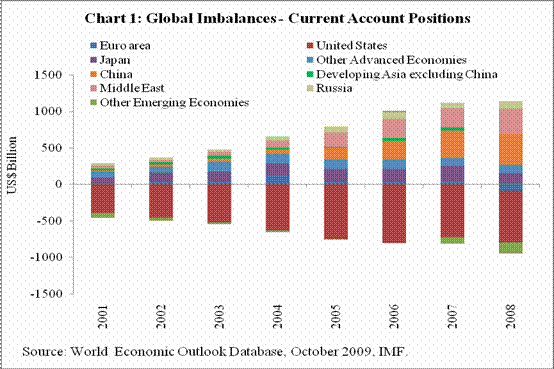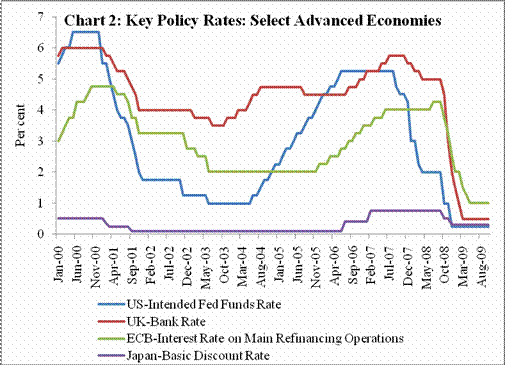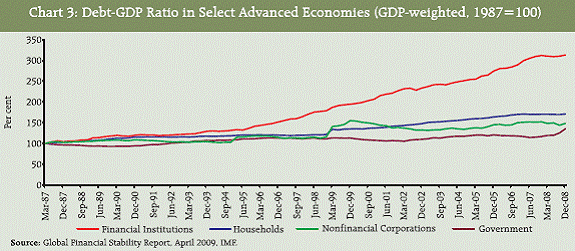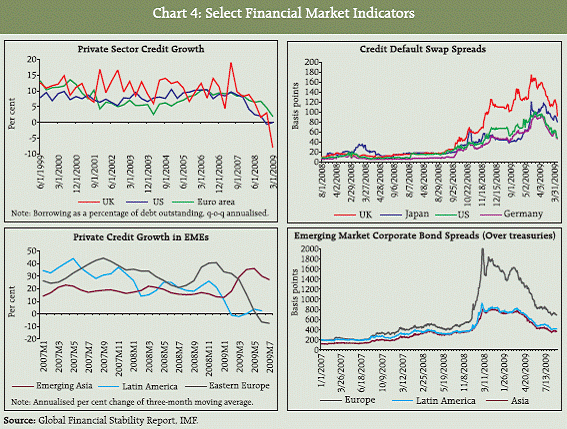 IST,
IST,


The Global Financial Crisis: Genesis, Impact and Lessons
Shri Deepak Mohanty, Executive Director, Reserve Bank of India
delivered-on ଫେବୃଆରୀ 09, 2010
Respected Dr. Reddy, Prof. T.N.Srinivasan, Prof. S. D. Tendulkar, Prof. T. Krishnakumar, distinguished invitees and friends. I thank the C.R.Rao Advanced Institute of Mathematics, Statistics and Computer Sciences and the University of Hyderabad for giving this opportunity to share my thoughts on the global financial crisis. I am humbled speaking on this subject in the presence of Dr. Reddy, the distinguished former Governor of the Reserve Bank of India, who is widely credited for having put in place prudential policies which shielded India from the worst effects of the global financial crisis. The world economy today seems to be recovering from the most severe crisis since the Great Depression of the 1930s. As you know, it surfaced in the subprime mortgage sector in the US in August 2007 and took the character of a global crisis in September 2008 following the collapse of Lehman Brothers. It is also dubbed as the greatest crisis in the history of financial capitalism because of the way it simultaneously propagated to other countries. The impact of the crisis can be gauged from the sharp upward revisions to the estimates of possible write-downs by banks and other financial institutions from about US$ 500 billion in March 2008 to about US$ 3.5 trillion in October 2009. More than the financial cost, the adverse impact on the real economy has been severe: in 2009, the world GDP is estimated by the IMF to have contracted by 0.8 per cent and the world trade volume is estimated to have declined by 12 per cent. The expanse of the crisis has tested all the limits of conventional and unconventional policy options available to policymakers around the world. In fact, the speed and intensity with which the US subprime crisis turned into a global financial crisis and then into a global economic crisis has led to a whole new debate on dominant tenets in macroeconomics. It has challenged the conventional views on the self-correcting nature of financial markets. The debate on the role of finance in economic growth has again come to the centre stage. Against this backdrop, I will reflect on the following set of questions. How similar or different is the recent crisis from the past crises in terms of its cause and manifestation? How did policies in different countries respond to the crisis? How and why was India impacted and how did we respond? What are the key lessons from the crisis? I will conclude with a focus on India. I. Genesis of the Crisis The crisis was an outcome of the interplay between both macroeconomic and microeconomic factors. From a macroeconomic perspective, the crisis has been attributed to the persistence of global imbalances, excessively accommodative monetary policy pursued in major advanced economies and lack of recognition of asset prices in policy formulation. From a microeconomic perspective, the crisis has been attributed to the rapid financial innovations without adequate regulation, credit boom and the lowering of credit standards, inadequate corporate governance and inappropriate incentive system in the financial sector and overall lax oversight of the financial system. Global Imbalances It is argued that while the subprime problem was the trigger, the root cause of the crisis lies in the persistence of the global imbalances since the start of the current decade (BIS, 2009). Large current account deficits in the advanced countries mirrored by large current account surpluses in the emerging market economies (EMEs) implied that excess saving flowed uphill from developing countries to developed countries (Chart 1 and Table 1). Bernanke (2005) considered this ‘saving glut’ as one of the factors leading to the crisis. Among the advanced countries, it is the US which has a large saving-investment gap. Among the EMEs, it is China, which has the largest saving surplus. The causation, however, is not very clear: whether it is excess saving in China or excess consumption in the US that contributed to the crisis.
Apart from the saving-investment imbalances, there has been concurrent accumulation of large foreign exchange reserves by the EMEs, particularly China, also as self insurance against sudden reversal of capital flows (Table 2). It is argued that accumulation of reserves, particularly from trade surplus, resulted in misalignment of exchange rates. This prevented the global imbalances to adjust. Moreover, the burden of adjustment was borne disproportionately by countries with flexible currencies. While there is merit in this argument, it is not clear whether movement in exchange rates by itself could have prevented global imbalances without an adjustment in aggregate demand – lower consumption in the US and higher consumption in China. Monetary Policy In a number of advanced countries, policy rates remained below what could be considered as neutral rates. Monetary policies in the US and Japan were too easy for too long (Truman, 2009). The US federal funds rate was lowered to 1 per cent by June 2003 while the Bank of Japan’s discount rate reached 0.1 per cent by September 2001. Subsequently, though policy rates were raised, they have been brought down again to their lowest levels following the crisis (Chart 2).
Many critics argue that the current low levels of policy rates may well be sowing the seeds for the next crisis. Notwithstanding the arguments on both the sides, one aspect is clear that monetary policy in advanced countries has spillover effect on the EMEs. Monetary Policy is generally conducted with the domestic objectives in view but the international spillover effects are not inconsequential. For example, increase in interest rate differential could engender excessive capital flows from developed countries to developing countries with an increasing risk of reversal unrelated to the fundamentals of the capital recipient countries. This can accentuate asset prices, put upward pressure on exchange rate, and could have destabilizing effects. Excess Leverage A comparison of the current crisis with various episodes of past crises reveals considerable similarity with regard to the underlying causes – excessive use of credit, lowering of credit standards, and heavy reliance on leverage. Reinhart and Rogoff (2009) find that the global dimension of the current crisis is neither new nor unique to this episode. Apart from perpetuating global imbalances, the easy monetary policy pursued in advanced economies encouraged excessive leveraging on the part of investors as well as banks and financial institutions. The sharp rise in the leverage of financial institutions in the first decade of this century has been particularly striking (Chart 3).
Search for Yields The low levels of interest rates led to the search for yields. This encouraged rapid financial innovations in terms of complex derivative instruments and structured finance products created through the process of securitization. Easy credit combined with under pricing of risks created speculative asset bubbles, especially in real estate. However, domestic macroeconomic policies in many cases could not take into account the build-up of systemic risks in the financial system arising from leverage and asset price bubbles, thereby contributing to the crisis. The financial system also was enlarged with the growth in off-balance sheet activities of banks through the process of ‘originate-to-distribute’ model. This shadow banking sector, however, remained beyond the pale of regulation. Consequently, both the investors and regulators increasingly relied on the assessment of rating agencies and independent auditors, who are supposed to provide a third-party evaluation of the risks embedded in various financial transactions. However, due to the existing flaws in the financial system and distorted incentive structures, the rating agencies issued unrealistically high ratings to new issuances, thereby contributing to the build-up of systemic risks. The crisis shows that the systemic risks posed by the immensely complex financial system were masked by the benign macroeconomic outcomes characterized as the ‘great moderation’. This prolonged period of high output growth and low inflation was essentially attributed to free markets and successful globalisation. During the golden years, financial economists believed that free-market economies could never go astray which is belied by the crisis (Krugman, 2009). The financial system, however, remained vulnerable to the risks of reversal in easy monetary policy on the one hand and disorderly unwinding of global imbalances on the other. It is argued that the ‘great moderation’ carried the seeds of its own destruction. This stability bred complacency, excessive risk taking and, ultimately, instability (Minsky, 2008). Furthermore, multilateral institutions like the IMF which were charged with the responsibility of surveillance, failed in diagnosing the vulnerabilities both at the global level and at the level of systemically important advanced economies (Reddy, 2009). II. Manifestation of the Crisis Interbank markets in advanced economies were the first to be affected by severe liquidity crisis as banks became reluctant to lend to each other on fear of counterparty risks. This was manifested in abnormal level of spreads, shortening of maturities, and contraction, or even closure, of some market segments (Table 3).
Transmission to the Real Sector With money markets witnessing a squeeze, equity prices plummeting and credit spreads rising, banks and other financial institutions experienced erosion in their access to funding and capital. The tightening of credit conditions combined with deleveraging and risk aversion by banks and financial institutions led to a sharp slowdown in private sector credit growth, particularly in the advanced economies, which worked as a channel for transmitting the crisis from financial institutions to the real economy (Chart 4). At the same time, the deteriorating macroeconomic conditions affected profitability. Consequently, the liquidity problem transformed into a solvency problem leading to bank failures in the US and other advanced economies in Europe. The attendant wealth loss on account of collapsing asset prices further accentuated the problem in the real sector.
Transmission to EMEs The crisis spread to the EMEs through all the three broad channels – confidence, finance and trade – reflecting increased global integration. The confidence channel worked in two ways. First, although the epicenter of crisis was in advanced markets, exposures to emerging markets were reduced sharply with the return of risk aversion. Second, with increase in deleveraging, there was a widespread shortage of US dollar. Consequently, reversal of capital flows led to equity market losses and currency depreciations (Table 4). The slump in export demand and tighter trade credit caused deceleration in aggregate demand. The banking system in the EMEs, however, showed relative resilience during the crisis because of their limited exposure to the toxic assets as also improved regulation and supervision in the aftermath of the East Asian crisis.
Policy Response The crisis evoked unprecedented policy response, both nationally and internationally. The resolution mechanisms that came to the fore had to contend with new and complex web of the financial world involving credit default swaps (CDS), special investment vehicles (SIVs) and credit ratings. Monetary authorities in the advanced economies were the first to resort to an aggressive monetary easing first by reducing policy rates and then by using their balance sheets in unconventional ways to augment liquidity. The large scale economic downturn accompanying the financial crisis also led to activation of counter-cyclical fiscal policy of unprecedented magnitudes. The fiscal measures focused on improving the balance sheet of the financial and corporate sectors as reflected in large scale bailouts in the US and other advanced economies. The EMEs also undertook various policy measures to limit the adverse impact of contagion and their policy responses became more coordinated with global efforts. A distinguishing feature, however, is that while for the advanced countries the policy priorities were to restore normalcy and strengthen financial regulation and supervision, dealing with the reversal of capital flows and collapse of trade occupied the policy attention in the EMEs. Notwithstanding such differences, restoring growth emerged as the overriding objective among both the set of countries. It was for the first time that EMEs turned out to be active partners in finding meaningful resolution mechanisms to a global problem. III. Impact and Policy Responses in India Why was India Impacted? In the initial phase of the crisis, the impact on the Indian financial markets was rather muted as the direct exposure of banks to subprime assets was negligible. Nonetheless, India could not remain unscathed for long. As the crisis intensified in the aftermath of collapse of Lehman Brothers, the global shocks first impacted the domestic financial markets and then transmitted to the real economy through the finance, trade and confidence channels. This could be attributed to the global nature of the current crisis on the one hand and accelerated trade and financial integration of the Indian economy with the world since the 1990s. Consequently, there has been a shift in the degree of synchronisation of the Indian trade and business cycles with the global cycles, which along with increased financial integration in the recent period indicate that India cannot remain immune to global trends. Thus, global economic developments now have a greater influence on the domestic economy (Mohanty, 2009). How was India Impacted? Post-Lehman, the impact of the global financial crisis was first felt through reversal of capital flows and fall in equity prices in the domestic stock markets on the back of large scale sell-off by the foreign institutional investors (FIIs) as a part of the global deleveraging process. Simultaneously, there was reduced access to external sources of funding by Indian entities due to the tightening of credit conditions in international markets. This shortage of dollar liquidity put significant pressures on the domestic foreign exchange market, which was reflected in downward pressures on the Indian rupee along with its increased volatility. Simultaneously, there was a substitution of overseas financing by domestic financing, which brought both money market and credit market under pressure. The transmission of this external demand shocks was swift and severe on India’s export growth, which turned negative in October 2008. Imports too started declining by December 2008 as domestic activity slowed. The overall impact was reflected in a fall in investment demand and sharp deceleration in the growth of Indian economy in the second half of 2008-09 which persisted through the first quarter of 2009-10. Policy Response In order to limit the adverse impact of the contagion on the Indian financial markets and the broader economy, the Reserve Bank, like most other central banks, took a number of conventional and unconventional measures. These included augmenting domestic and foreign exchange liquidity and sharp reduction in the policy rates. The Reserve Bank used multiple instruments such as the liquidity adjustment facility (LAF), open market operations (OMO), cash reserve ratio (CRR) and securities under the market stabilization scheme (MSS) to augment the liquidity in the system. In a span of seven months between October 2008 and April 2009, there was unprecedented policy activism. For example: (i) the repo rate was reduced by 425 basis points to 4.75 per cent, (ii) the reverse repo rate was reduced by 275 basis points to 3.25 per cent, (iii) the CRR was reduced by a cumulative 400 basis points to 5.0 per cent, and (iv) the actual/potential provision of primary liquidity was of the order of Rs. 5.6 trillion (10.5 per cent of GDP). These measures were effective in ensuring speedy restoration of orderly conditions in the financial markets over a short time span. These measures were supported by fiscal stimulus packages during 2008-09 in the form of tax cuts, investment in infrastructure and increased expenditure on government consumption. The expansionary fiscal stance continues during 2009-10 to support aggregate demand. While the magnitude of the crisis was global in nature, the policy responses were adapted to domestic growth outlook, inflation conditions and financial stability considerations. Until the emergence of global crisis, the Indian economy passed through a phase of high growth driven by domestic demand: growing domestic investment financed mostly by domestic savings and sustained consumption demand. This overall improvement in macroeconomic performance in India could mainly be attributed to the sequential financial sector reforms that resulted in an efficient system of financial intermediation, albeit bank-based; the rule-based fiscal policy that reduced the public sector’s drag on private savings; and forward looking monetary policy that balanced the short-term trade-off between growth and inflation. IV. Lessons from the Crisis The crisis has shown that irrespective of the degree of globalisation of a country and the soundness of domestic policies, it can be impacted by a crisis in any other economy due to the interlinkages in the global economy. With the benefit of hindsight, a number of important issues have emerged which allows us to draw lessons. I will highlight four key lessons. First, the policy objectives of central banks would have to be broader than price stability as conventionally defined. The lesson for central banks that emerged from the crisis is that financial stability can be jeopardised even if there is price stability and macroeconomic stability (Subbarao, 2009). Moreover, the success in stabilising goods and services prices may not preclude inflation in asset prices, causing unsustainable speculation leading to asset booms. Thus, apart from price stability, the central banks would have to take into account asset prices and focus on financial stability as an explicit objective of policy. While there is more of an agreement to recognise financial stability as an objective, there is less of an agreement about the instrumentalities for achieving this objective. There is a broader acceptance of macroprudential tools for asset prices. It is, however, not apparent at this stage as to what extent policy interest rates could be used to address asset price inflation. Second, there is a need for fiscal consolidation to generate the fiscal space for macro management. During the crisis, fiscal policy responses have been unprecedented, although they were conditioned by country-specific factors. But the massive fiscal support, though appropriate as a crisis response, has raised questions about debt sustainability. This is reflected in increase in sovereign CDS spreads even for advanced countries which has implications for macro-financial stability going forward. It is, therefore, important that fiscal buffers are established in good times to provide the necessary fiscal space for counter-cyclical fiscal measures in bad times. Third, financial institutions would have to be less leveraged and better regulated. This financial crisis brought into sharp focus the interlinkages among the financial institutions, markets and the payment and settlement systems. It has shown that market self regulation has limits. Hence, all systemically important financial institutions, markets and instruments should be subject to an appropriate degree of regulation and oversight depending on their relative importance for overall financial stability. At the same time, it needs to be recognised that regulation in itself can act to magnify cycles. In order to address the issue of pro-cyclicality, regulators need to focus on: identifying factors that amplify cycles; improving and diversifying market risk management models; undertaking more rigorous stress testing; and adopt forward-looking procedures to capital calculations. Fourth, the international financial architecture needs to be strengthened to address the challenges of the global economy of the 21st century. The crisis has exposed fundamental problems, not only in national regulatory systems affecting finance, competition and corporate governance, but also in the international institutions and arrangements created to ensure financial and economic stability. The IMF, the Financial Stability Board (FSB) and the G-20 should provide the effective platform for addressing global issues in a more credible manner. The IMF would have to play a more active role in crisis prevention, management and resolution. It needs to strengthen its multilateral surveillance with a greater macro-financial focus. In this context, the G-20 emphasis on modernizing the IMF’s governance process is a welcome step which should improve its credibility, legitimacy and effectiveness. The G-20 can provide the necessary political support for implementation of policies which need a coordinated effort at the global level. V. Conclusions India was relatively less impacted by the crisis despite increased global integration of the Indian economy in recent years. This could be attributed mainly to the structure of the economy, cautious policies, prudent regulation and effective supervision. First, India’s economic growth is largely domestic driven – high investment financed by high domestic saving. Second, de-regulation and opening up of the economy was sequenced appropriately. Along with the opening up of the economy, the financial markets were also developed to improve efficiency in financial intermediation. Third, the Reserve Bank also being the regulator and supervisor of the financial system, information related to financial system always flowed to the central bank, which helped in fine tuning the monetary policy. In fact, financial stability as a monetary policy objective in India emerged much before the unraveling of the current crisis. Fourth, the multiple indicator approach to the conduct of monetary policy in India helped in identifying credit market excesses and undertaking counter-cyclical monetary policy measures in a pre-emptive manner. Fifth, monetary policy was well supported by macroprudential measures to ensure that it does not impinge on financial stability. Pro-cyclical measures in respect of capital and provisioning were tried in 2005, much before the crisis. Sixth, in view of systemic implications of non-banks, they have been brought within the regulatory framework in terms of prescriptions of capital adequacy and exposure norms. Banks’ exposures to these entities are subject to prudential regulations. Seventh, the liquidity risks are contained by restricting the overnight unsecured market to banks and primary dealers (PDs), with prudential limits. The requirement of statutory liquidity ratio (SLR) for banks acts as a buffer for both liquidity and solvency of banks. Although cautious macroeconomic policies coupled with macroprudential regulations helped limit the adverse impact on the Indian economy, there is no room for complacency. As highlighted by Governor Dr. Subbarao, there are lessons from the crisis for India too, which include: (i) further strengthening regulation at the systemic and institutional levels; (ii) making our supervision more effective and value adding; and (iii) improving our skills in risk management. India has been an active participant at the global discussions, the task for us will be to reflect our point of view in the global debate and adapt the global policies and guidelines to the Indian situation on a dynamic basis. Furthermore, we need to actively pursue the challenge of financial inclusion. The functioning of global economy in the past three decades suggests that the process of financial development and globalisation is susceptible to crisis. Nevertheless, the recurrence of financial crisis has not changed the positive relation between financial development and growth (Lipsky, 2009). As the current crisis shows, the problems in finance and financial regulation need to be addressed at a national as well as global level to ensure that the benefits of financial developments become more widespread and enduring in nature. Thus, what is needed is not more regulation but sharper regulation of the financial system to ensure sustained financial development with stability. Select References 1. Bank for International Settlements (2009), 79th Annual Report, June. 2. Bernanke, Ben S. (2004), “The Great Moderation”, Remarks at the Meetings of the Eastern Economic Association, Washington, DC. 3. _____ (2005), “The Global Saving Glut and the U.S. Current Account Deficit”, Remarks at the Sandridge Lecture, Virginia Association of Economics, Richmond, Virginia. 4. Calomiris, Charles W. (2009). “Financial Innovation, Regulation, and Reform”, Cato Journal, Vol. 29, No. 1. 5. Global Financial Stability Report (2009), International Monetary Fund, April and October. 6. Krugman, Paul (2009), “How Did Economists Get It So Wrong?” The New York Times, September 2. 7. Lipsky, John (2009), “Finance and Economic Growth”, Remarks at the Bank of Mexico Conference, Mexico City. 8. Minsky, Hyman P. (2008), Stabilizing an Unstable Economy, McGraw-Hill Publications. 9. Mohanty, Deepak (2009), “Global Financial Crisis and Monetary Policy Response in India”, Speech delivered at the 3rd ICRIER-InWEnt Annual Conference on 12th November, 2009 in New Delhi. 10. Reddy, Y.V. (2009), “Epilogue” in India and the Global Financial Crisis: Managing Money and Finance, Orient Blackswan, New Delhi. 11. Reinhart, Carmen M., and Kenneth S. Rogoff (2009), This Time is Different: Eight Centuries of Financial Folly, Princeton University Press. 12. Subbarao, D. (2009), “Financial Stability: Issues and Challenges”, Valedictory address at the FICCI-IBA Annual Conference on ‘Global Banking: Paradigm Shift’ organised jointly by FICCI and IBA on September 10. 13. The Turner Review (2009), “A Regulatory Response to the Global Banking Crisis”, Financial Sector Authority, UK, March. 14. Truman, Edwin M. (2009), “Lessons from the Global Economic and Financial Crisis”, Keynote address at the conference “G-20 Reform Initiatives: Implications for the Future of Regulation”, co-hosted by the Institute for the Global Economics and the International Monetary Fund, Seoul, Korea, November 11. * Speech by Deepak Mohanty, Executive Director, Reserve Bank of India in Hyderabad on December 30, 2009 at the International Conference on Frontiers of Interface between Statistics and Science organized in honour of Prof. C.R.Rao on the occasion of his 90th birthday by the C. R. Rao Advanced Institute of Mathematics, Statistics and Computer Science and the University of Hyderabad. The assistance provided by Dr. Rajiv Ranjan and Shri Binod B. Bhoi is acknowledged. |
|||||||||||||||||||||||||||||||||||||||||||||||||||||||||||||||||||||||||||||||||||||||||||||||||||||||||||||||||||||||||||||||||||||||||||||||||||||||||||||||||||||||||||||||||||||||||||||||||||||||||||||||||||||||||||||||||||||||||||||||||||||||||||||||||||||||||||||||||||||||||||||||





















